TRIVETTE HISTORICAL PICTURES - 2 OF 3
-- 1974 --
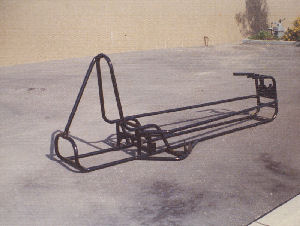 Rear 3/4 view of the production frame.
Rear 3/4 view of the production frame.
-COMPLETE WITH ROLLBAR-
-- 1975 --
 Open-chassis picture of the car for Nishikata - front view.
Open-chassis picture of the car for Nishikata - front view.
A driveable version of the vehicle just needing the body to be complete.
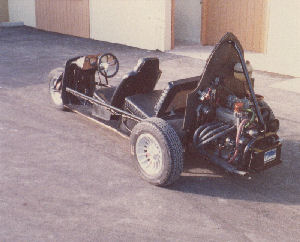 Open-chassis picture of the car for Nishikata - 3/4 rear view.
Open-chassis picture of the car for Nishikata - 3/4 rear view.
Another body-off view of the car - really shows off the parts layout. Notice the cable cluster running along the left rail.
These cables are used for gauges and controls. The cabin heater is under the front seat and the gas tank is under the rear seat!!
The original car didn't have a heater when Bob and Diana took the car for a few days' drive in January over the snowy Siskiyou
Mountains. It got so cold in the TriVette on the way over the mountains that Bob designed and installed a heater for the drive back!!!
It worked great and was incorporated in all production TriVettes.
-- 1976 --
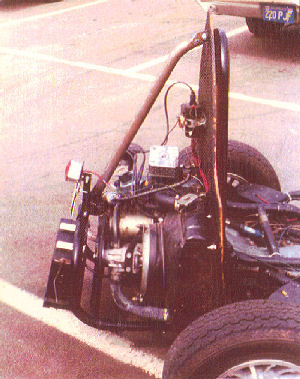 A open-chassis view of the TriVette that was crashed by one of Bob's employees (a younger guy) on Palma Drive. He was taking the open
chassis TriVette for a test drive to make sure everything was operating properly. He was flying down Palma Drive when a guy in a big
6,000 lb Ford station wagon pulled out in front of him from one of the local businesses. He hit the station wagon right at its
firewall in front of the driver's door. There was 14 feet of skid marks and the estimated impact speed was 45 to 50 MPH. He had no seat
belt on and was taken to the hospital where he only needed a few stitches in his left knee where it hit the dash. He tore a 10"
round circle in his "T" shirt but he was back working the next day. In a typical passenger car that would have been a fatal accident.
Bob told me that typically a passenger car doing 30 MPH into a solid barrier is a fatal accident. The Ford station wagon moved about
6 inches. The TriVette's front suspension, the wheel, and the down tube absorbed the impact, progressively giving distance and time
for deceleration. In the picture you can see that the top of the battery is tipped forward and the entire engine is up against the
rear plywood bulkhead. This means that the energy absorption went clear to the rear of the vehicle. Again, this is the side view
after the crash.
A open-chassis view of the TriVette that was crashed by one of Bob's employees (a younger guy) on Palma Drive. He was taking the open
chassis TriVette for a test drive to make sure everything was operating properly. He was flying down Palma Drive when a guy in a big
6,000 lb Ford station wagon pulled out in front of him from one of the local businesses. He hit the station wagon right at its
firewall in front of the driver's door. There was 14 feet of skid marks and the estimated impact speed was 45 to 50 MPH. He had no seat
belt on and was taken to the hospital where he only needed a few stitches in his left knee where it hit the dash. He tore a 10"
round circle in his "T" shirt but he was back working the next day. In a typical passenger car that would have been a fatal accident.
Bob told me that typically a passenger car doing 30 MPH into a solid barrier is a fatal accident. The Ford station wagon moved about
6 inches. The TriVette's front suspension, the wheel, and the down tube absorbed the impact, progressively giving distance and time
for deceleration. In the picture you can see that the top of the battery is tipped forward and the entire engine is up against the
rear plywood bulkhead. This means that the energy absorption went clear to the rear of the vehicle. Again, this is the side view
after the crash.
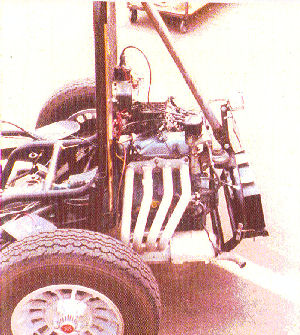 The left side of the engine after the accident with the engine moved well forward.
The left side of the engine after the accident with the engine moved well forward.
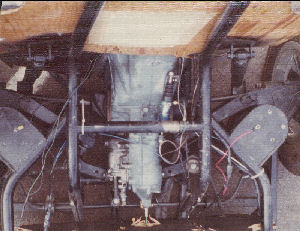 Looking straight down on top of the clutch housing, final drive and transmission. There's a vertical 1-1/2" diameter 095 wall
tube that was about 1/2" in front of the rear axle. The energy stopping the engine and the bending of the engine and transmission
mounts allowed the engine to move forward. You can see where the nose of the transmission shattered the plywood bulkhead that was
right in front of the transmission and also see the bent motor mounts. What stopped the engine was the vertical piece of
tubing that's just barely in front of the axle halfshafts. From this picture you can see that the halfshaft is actually bent. This
is a substantial piece of metal. This is what stopped the whole thing from going into the passenger compartment. So this vehicle was
more successful at absorbing impact energy than passenger cars of that day.
Looking straight down on top of the clutch housing, final drive and transmission. There's a vertical 1-1/2" diameter 095 wall
tube that was about 1/2" in front of the rear axle. The energy stopping the engine and the bending of the engine and transmission
mounts allowed the engine to move forward. You can see where the nose of the transmission shattered the plywood bulkhead that was
right in front of the transmission and also see the bent motor mounts. What stopped the engine was the vertical piece of
tubing that's just barely in front of the axle halfshafts. From this picture you can see that the halfshaft is actually bent. This
is a substantial piece of metal. This is what stopped the whole thing from going into the passenger compartment. So this vehicle was
more successful at absorbing impact energy than passenger cars of that day.
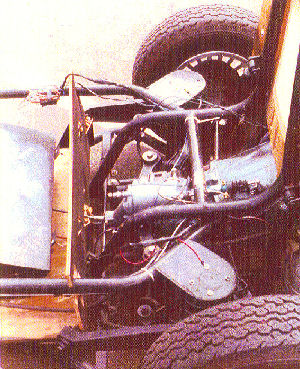 Side view from the left side again showing how far the motor mounts are bent and how the plywood was extremely effective at absorbing
the impact energy.
Side view from the left side again showing how far the motor mounts are bent and how the plywood was extremely effective at absorbing
the impact energy.
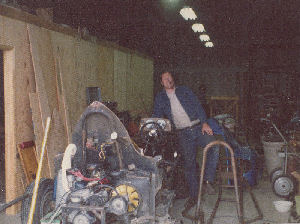 This is Bob in the shop with a foot on a chassis and leaning on another near completion.
This is Bob in the shop with a foot on a chassis and leaning on another near completion.
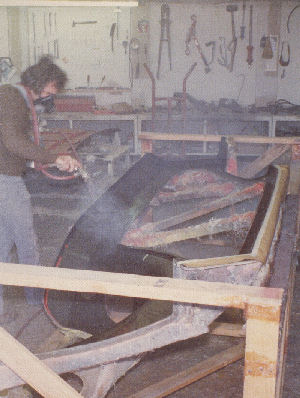 The fiberglass shop in Compton California - Fiberon. Here they're making the right hand gullwing door. The fiberglass from the
chopper gun setup is being sprayed into the mold to make the new door.
The fiberglass shop in Compton California - Fiberon. Here they're making the right hand gullwing door. The fiberglass from the
chopper gun setup is being sprayed into the mold to make the new door.
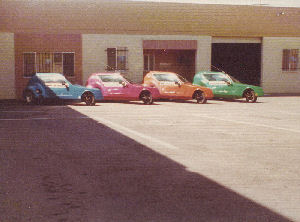 4 TriVettes in front of the shop at 1499 Palma Drive. The green one was for Paul Stantion in Simi Valley California.
4 TriVettes in front of the shop at 1499 Palma Drive. The green one was for Paul Stantion in Simi Valley California.
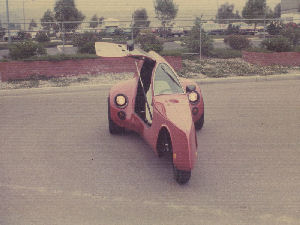 The number one production vehicle in the rear lot. The California Highway Patrol office is in the background just north of their
production facility. This TriVette is now found at Bob's home in New York.
The number one production vehicle in the rear lot. The California Highway Patrol office is in the background just north of their
production facility. This TriVette is now found at Bob's home in New York.
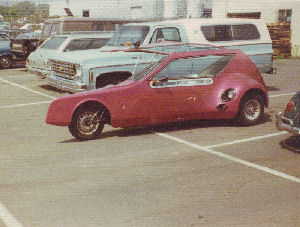 This is to show a size comparison between a TriVette and a 1975 Chevy pickup. You can see it's almost as long as a full size
pickup.
This is to show a size comparison between a TriVette and a 1975 Chevy pickup. You can see it's almost as long as a full size
pickup.
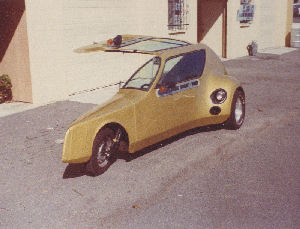 This gold vehicle was delivered to Tepfer in El Monte.
This gold vehicle was delivered to Tepfer in El Monte.
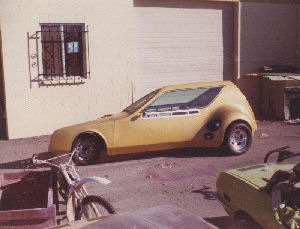 Same as above but behind the shop.
Same as above but behind the shop.
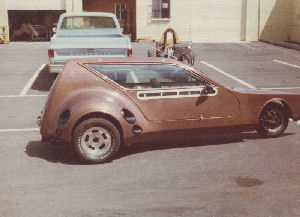 A brown TriVette.
A brown TriVette.
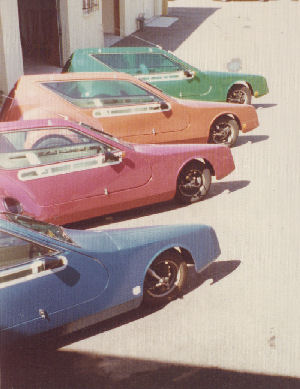 A collection of 4 TriVettes. The green one was Paul Stantion's of Simi Valley.
A collection of 4 TriVettes. The green one was Paul Stantion's of Simi Valley.
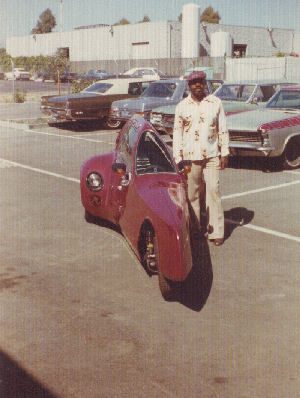 An enterprising young man from Compton, California with his iridescent purple TriVette that he used in his business.
An enterprising young man from Compton, California with his iridescent purple TriVette that he used in his business.
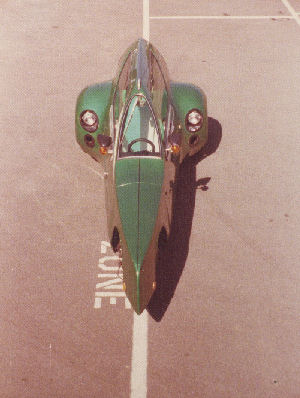 A front overhead view of Paul Stantion's green goldflake TriVette.
A front overhead view of Paul Stantion's green goldflake TriVette.
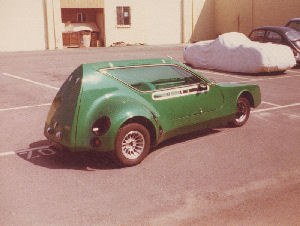 Another view of Paul's TriVette.
Another view of Paul's TriVette.

